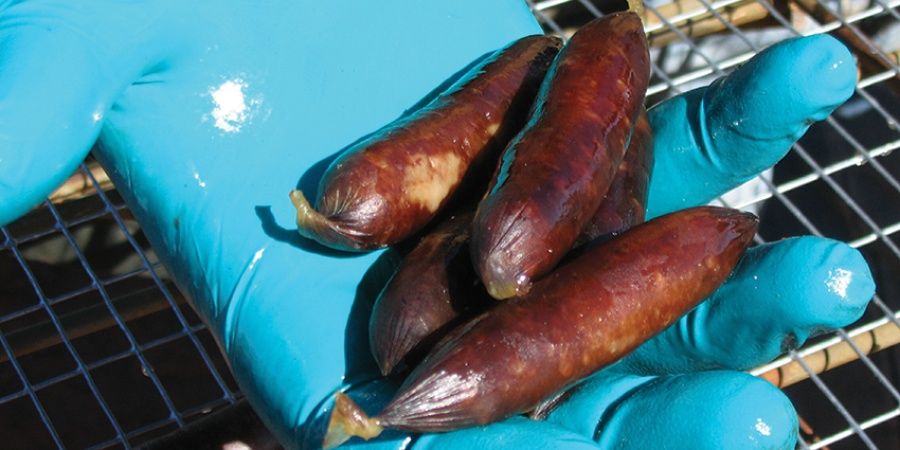
Eeradicat cat baits
Eradicat® is a small, palatable 1080 sausage bait developed and produced by DBCA to target feral cats. Each bait contains 4.5mg of 1080 (sodium fluroacetate), a toxin that occurs naturally in Australian Gastrolobium pea plants.
Native animals tolerant to baits
Unlike introduced predators, native Australian animals have developed a tolerance to the toxin as they have co-evolved with these plants over millions of years. Pet dogs and cats are highly susceptible to 1080 poisoning. Pet owners must be aware and avoid taking domestic animals into areas managed for foxes or feral cats. Eradicat® is the only ready-to-lay bait registered for feral cats in WA.
How Eradicat® is used
Eradicat® is best suited for aerial baiting, which has applicability for large, landscape-scale projects, for example, baiting over an entire island or conservation reserve. Aerial deployment of Eradicat® was used for the initial knockdown of feral cats on Dirk Hartog Island, the largest island in the world on which feral cats have been eradicated. It resulted in an 80% success rate in GPS-collared cats. Eradicat® is used to manage cats in Kalbarri National Park to protect chuditch and black-flanked rock wallabies and at Matuwa Kurrarra-Kurrara to protect bilbies.
When using baits to control feral cats, it is important to consider the risk of non-target species taking the baits. Baits should be used in areas where the likelihood of feral cats encountering baits is high and where non-target species have a high tolerance to 1080. A risk assessment framework has been developed to assist land managers in determining the level of risk.
Legislation and policy
The following policy and legislative requirements govern the use of Eradicat® in Western Australia.
| Code of Practice for the safe use and management of registered pesticides containing 1080, PAPP and Strychnine (Department of Health) | 1080 is classified as a Schedule 7 poison under the Medicines and Poisons Act 2014. To purchase and use 1080 products, appropriate training and proper authorisation are required. A baiting application and risk assessment must be completed before purchasing and using a registered pesticide, including 1080, under the Code. The risk assessment determines if the application meets the distance restrictions outlined below and other non-target considerations. Following the successful approval and risk assessment, a permit/voucher is issued to purchase baits. Approval for 1080 will only be issued for land holdings under 20 hectares in size if it is part of a coordinated community baiting program. These programs are assessed on a case-by-case basis and will require documentation from each landholder as evidence of the coordinated approach. |
| Policy and Declaration of feral cats under the Biosecurity and Agriculture Management Act 2007 (BAM Act) | In 2019, feral cats were declared under the BAM Act. A supporting policy was established to outline strategies for targeted feral cat management. The policy and declaration prescribe control measures to minimise the potential risk to domestic cats. The policy also provides definitions of the different categories of cats, including feral, stray and domestic cats. |
| DBCA bait manufacture facility | DBCA’s bait manufacture facility is registered for wholesale production and sales, restricting the facility's ability to sell directly to the public. For further information, contact the factory email: baitmanufacturefacility@dbca.wa.gov.au |
| Eradicat® label | Restrictions on the use of Eradicat® in WA are outlined on the label. The label specifies a single aircraft baiting per calendar year and the density of baits per square kilometre. For ground baiting operations, individual baits must be laid on top of the ground at 200m intervals and not exceed 10 baits per square kilometre. If Eradicat® is proposed for use in habitats where northern quolls are or may be present, additional approvals and an Australian Pesticides and Veterinary Medicines Authority (APVMA) off-label permit are required. |
| DBCA Feral Cat Technical Committee | The committee is responsible for reviewing applications to use Eradicat® in Western Australia and is made up of staff from multiple divisions of DBCA. Before submitting a 1080 baiting application, an application to use Eradicat® must be made to this committee. The committee will undertake a high-level assessment of the proposed project, considering the objective of the program, scale, conservation values to be protected, and the monitoring that will be implemented as part of the baiting program. The committee also evaluates DBCA’s ability to meet the project’s needs, including providing baits. |
More information
For further information and to receive the Jot Form baiting application link, please email ecosystemhealth@dbca.wa.gov.au.